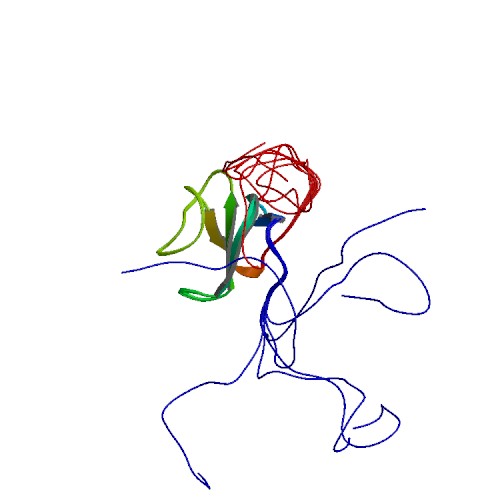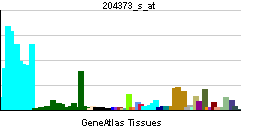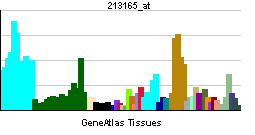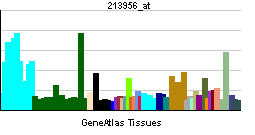CEP350
| Centrosomal protein 350kDa | |||||||||||||
|---|---|---|---|---|---|---|---|---|---|---|---|---|---|
 PDB rendering based on 2coz. | |||||||||||||
| |||||||||||||
| Identifiers | |||||||||||||
| Symbols | CEP350 ; CAP350; FLJ38282; FLJ44058; KIAA0480; gm133 | ||||||||||||
| External IDs | Template:MGI HomoloGene: 8879 | ||||||||||||
| |||||||||||||
| RNA expression pattern | |||||||||||||
 | |||||||||||||
 | |||||||||||||
 | |||||||||||||
| More reference expression data | |||||||||||||
| Orthologs | |||||||||||||
| Template:GNF Ortholog box | |||||||||||||
| Species | Human | Mouse | |||||||||||
| Entrez | n/a | n/a | |||||||||||
| Ensembl | n/a | n/a | |||||||||||
| UniProt | n/a | n/a | |||||||||||
| RefSeq (mRNA) | n/a | n/a | |||||||||||
| RefSeq (protein) | n/a | n/a | |||||||||||
| Location (UCSC) | n/a | n/a | |||||||||||
| PubMed search | n/a | n/a | |||||||||||
Centrosomal protein 350kDa, also known as CEP350, is a human gene.[1]
The product of this gene is a large protein with a CAP-Gly domain typically found in cytoskeleton-associated proteins. The encoded protein primarily localizes to the centrosome, a non-membraneous organelle that functions as the major microtubule-organizing center in animal cells. The encoded protein directly interacts with another large centrosomal protein and is required to anchor microtubules at the centrosome. It is also implicated in the regulation of a class of nuclear hormone receptors in the nucleus. Several alternatively spliced transcript variants have been found, but their full-length nature has not been determined.[1]
References
Further reading
- Andersson B, Wentland MA, Ricafrente JY; et al. (1996). "A "double adaptor" method for improved shotgun library construction". Anal. Biochem. 236 (1): 107–13. doi:10.1006/abio.1996.0138. PMID 8619474.
- Bonaldo MF, Lennon G, Soares MB (1997). "Normalization and subtraction: two approaches to facilitate gene discovery". Genome Res. 6 (9): 791–806. PMID 8889548.
- Yu W, Andersson B, Worley KC; et al. (1997). "Large-scale concatenation cDNA sequencing". Genome Res. 7 (4): 353–8. PMID 9110174.
- Seki N, Ohira M, Nagase T; et al. (1998). "Characterization of cDNA clones in size-fractionated cDNA libraries from human brain". DNA Res. 4 (5): 345–9. PMID 9455484.
- Makalowska I, Sood R, Faruque MU; et al. (2002). "Identification of six novel genes by experimental validation of GeneMachine predicted genes". Gene. 284 (1–2): 203–13. PMID 11891061.
- Strausberg RL, Feingold EA, Grouse LH; et al. (2003). "Generation and initial analysis of more than 15,000 full-length human and mouse cDNA sequences". Proc. Natl. Acad. Sci. U.S.A. 99 (26): 16899–903. doi:10.1073/pnas.242603899. PMID 12477932.
- Andersen JS, Wilkinson CJ, Mayor T; et al. (2003). "Proteomic characterization of the human centrosome by protein correlation profiling". Nature. 426 (6966): 570–4. doi:10.1038/nature02166. PMID 14654843.
- Ota T, Suzuki Y, Nishikawa T; et al. (2004). "Complete sequencing and characterization of 21,243 full-length human cDNAs". Nat. Genet. 36 (1): 40–5. doi:10.1038/ng1285. PMID 14702039.
- Patel H, Truant R, Rachubinski RA, Capone JP (2005). "Activity and subcellular compartmentalization of peroxisome proliferator-activated receptor alpha are altered by the centrosome-associated protein CAP350". J. Cell. Sci. 118 (Pt 1): 175–86. doi:10.1242/jcs.01600. PMID 15615782.
- Yan X, Habedanck R, Nigg EA (2006). "A complex of two centrosomal proteins, CAP350 and FOP, cooperates with EB1 in microtubule anchoring". Mol. Biol. Cell. 17 (2): 634–44. doi:10.1091/mbc.E05-08-0810. PMID 16314388.
- Oh JH, Yang JO, Hahn Y; et al. (2006). "Transcriptome analysis of human gastric cancer". Mamm. Genome. 16 (12): 942–54. doi:10.1007/s00335-005-0075-2. PMID 16341674.
- Kimura K, Wakamatsu A, Suzuki Y; et al. (2006). "Diversification of transcriptional modulation: large-scale identification and characterization of putative alternative promoters of human genes". Genome Res. 16 (1): 55–65. doi:10.1101/gr.4039406. PMID 16344560.
- Nousiainen M, Silljé HH, Sauer G; et al. (2006). "Phosphoproteome analysis of the human mitotic spindle". Proc. Natl. Acad. Sci. U.S.A. 103 (14): 5391–6. doi:10.1073/pnas.0507066103. PMID 16565220.
- Gregory SG, Barlow KF, McLay KE; et al. (2006). "The DNA sequence and biological annotation of human chromosome 1". Nature. 441 (7091): 315–21. doi:10.1038/nature04727. PMID 16710414.
- Lim J, Hao T, Shaw C; et al. (2006). "A protein-protein interaction network for human inherited ataxias and disorders of Purkinje cell degeneration". Cell. 125 (4): 801–14. doi:10.1016/j.cell.2006.03.032. PMID 16713569.
- Olsen JV, Blagoev B, Gnad F; et al. (2006). "Global, in vivo, and site-specific phosphorylation dynamics in signaling networks". Cell. 127 (3): 635–48. doi:10.1016/j.cell.2006.09.026. PMID 17081983.
- Hoppeler-Lebel A, Celati C, Bellett G; et al. (2007). "Centrosomal CAP350 protein stabilises microtubules associated with the Golgi complex". J. Cell. Sci. 120 (Pt 18): 3299–308. doi:10.1242/jcs.013102. PMID 17878239.
| This protein-related article is a stub. You can help Wikipedia by expanding it. |